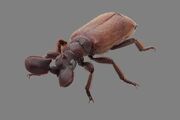AntWiki: The Ants --- Online
Antwiki provides a wealth of information on the world's ants.
32,374 articles and
125,498 uploaded files by ant experts from around the world.
|
|
|
|
New Ant Website
Ants of Cyprus is a new web site that aims to aggregate, summarize and present all available knowledge on the ants of Cyprus, while investigating the island's ant biodiversity, their spatiotemporal patterns and biological invasions of alien species.
It is dynamic, user-friendly website that can be used by anyone. If you are a researcher studying ants, insects etc. or simply interested in ants, their complex lifestyle or ecological significance you should visit this site!
|
 A major worker/soldier with swollen abdomen (food storage), minors, and brood of Carebara jajoby (Image by Christian Peeters). |
An image from the 2018 revision of the Carebara of the Malagasy Region by Azore and Fisher. [1].
|
|
|
|
Taxa Described
|
Most Viewed Pages
|
|
16 subfamilies
345 genera
64 subgenera
14457 species
1742 subspecies
5 fossil subfamilies
175 fossil genera
918 fossil species and subspecies
|
This Year
Last Year
All Years
|
All Pages: Brazil, Australian Ants, Argentina, Australia, Panama, Colombia, Ants of the Navajo Reservation, Ecuador, Borneo
Genera: Aphaenogaster, Camponotus, Aenictus, Cerapachys, Acropyga, Anochetus, Formica, Crematogaster, Leptogenys, Tetramorium, Pheidole, Polyrhachis
Species: Lasius niger, Solenopsis invicta, Cardiocondyla emeryi, Acropyga acutiventris, Camponotus herculeanus, Myrmica rubra, Monomorium floricola, Acropyga epedana, Myrmica scabrinodis, Camponotus ligniperda
Biology: Life in an Ant Colony, Social Parasitism, The Ants, Ritualised fighting in Iridomyrmex purpureus, Foraging behaviors in Poneroids and Ectatomminae
|
















